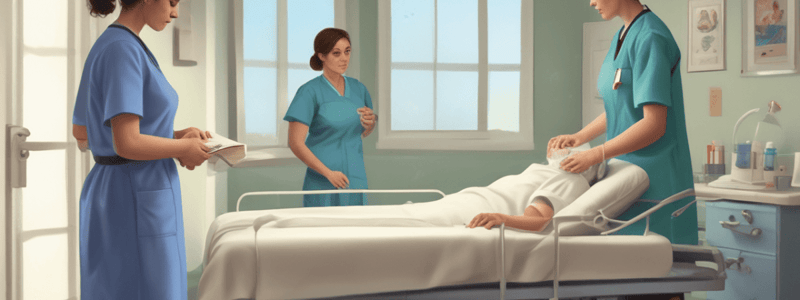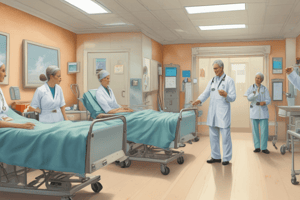Podcast
Questions and Answers
What should you do before raising the lift during a transfer?
What should you do before raising the lift during a transfer?
- Position the sling pad even with the back of the resident's knee (correct)
- Open the legs of the lift for a wide base of support
- Ask the resident to place their arms across their chest
- Secure the resident in the straps or slings
Why should residents wear skid-proof shoes when using ambulation devices?
Why should residents wear skid-proof shoes when using ambulation devices?
- To improve balance and stability
- To prevent falls due to slippery floors (correct)
- To make it easier to walk with a walker
- To reduce the risk of getting tired
What is the correct way to use a walker?
What is the correct way to use a walker?
- Hold the walker with both hands and take large steps
- Stand still, place the walker forward with all four legs solidly on the floor, and step forward (correct)
- Stand still, place the walker behind you, and step backward
- Use the walker only for balance, not for support
When using crutches, what should be the correct position of the elbows?
When using crutches, what should be the correct position of the elbows?
Why should you use a transfer (gait) belt when assisting a resident to walk?
Why should you use a transfer (gait) belt when assisting a resident to walk?
When assisting a visually impaired resident to walk, what should you do?
When assisting a visually impaired resident to walk, what should you do?
What should you do before helping a resident to stand up from a chair?
What should you do before helping a resident to stand up from a chair?
What is the primary reason for using lifts in a healthcare facility?
What is the primary reason for using lifts in a healthcare facility?
What is the correct placement of a cane for a resident with a weak side?
What is the correct placement of a cane for a resident with a weak side?
What should you do after positioning the sling pad during a transfer?
What should you do after positioning the sling pad during a transfer?
When moving a wheelchair down a steep ramp, what should you do?
When moving a wheelchair down a steep ramp, what should you do?
Why should you use a quad cane for some residents?
Why should you use a quad cane for some residents?
Why is it important to check the weight limit of a lift?
Why is it important to check the weight limit of a lift?
What is the primary purpose of using blankets and tubing on a wheelchair?
What is the primary purpose of using blankets and tubing on a wheelchair?
When should you push a wheelchair from behind?
When should you push a wheelchair from behind?
What should you do when moving a wheelchair around a corner?
What should you do when moving a wheelchair around a corner?
Why is it important to have at least two staff members present when operating a lift?
Why is it important to have at least two staff members present when operating a lift?
What should you do before operating a lift?
What should you do before operating a lift?
What type of lift is used to assist residents who need help standing up?
What type of lift is used to assist residents who need help standing up?
Why is it important to use a wheelchair that has been designated as appropriate for the resident?
Why is it important to use a wheelchair that has been designated as appropriate for the resident?
What is the primary purpose of checking the brakes on a wheelchair?
What is the primary purpose of checking the brakes on a wheelchair?
What should you do before pushing or repositioning a wheelchair?
What should you do before pushing or repositioning a wheelchair?
What is the purpose of swinging the front rigging out of the way during transfers?
What is the purpose of swinging the front rigging out of the way during transfers?
Why should you not let the resident stand on the footplates?
Why should you not let the resident stand on the footplates?
What should you do when lifting a resident from a wheelchair?
What should you do when lifting a resident from a wheelchair?
What is the primary purpose of using lifts in a healthcare setting?
What is the primary purpose of using lifts in a healthcare setting?
What should you check before transporting a resident in a wheelchair?
What should you check before transporting a resident in a wheelchair?
What is the primary purpose of using walkers in a healthcare setting?
What is the primary purpose of using walkers in a healthcare setting?
Why should you not push a wheelchair backward?
Why should you not push a wheelchair backward?
What should you do before collapsing a wheelchair?
What should you do before collapsing a wheelchair?
Flashcards are hidden until you start studying
Study Notes
Mobility and Ambulation Techniques
- Lock all brakes after positioning the lift (if applicable)
- Secure the resident in straps or slings and ask them to place their arms across their chest
- Raise the lift slowly and open the legs of the lift before transferring the resident
Ambulation Devices: Safety Concerns
- Devices used for walking should have skid-proof tips
- Residents should wear skid-proof shoes
- Follow the plan of care to determine which device the resident uses
- Use the resident's personal walker, cane, or crutches
Safety Devices: Walker
- Stand still, place the walker forward with all four legs solidly on the floor, and step forward
- Many types of walkers are available for different needs
- Practice: walking, sitting down and standing up from a chair, assisting another to walk with a walker, and adjusting the height of a walker
Safety Devices: Crutches
- Crutches should have some space between the top of the crutch and axilla
- The elbows should be flexed slightly, and the weight should be supported on the palms of the hands
- Practice: walking with crutches and adjusting crutches to fit
Safety Devices: Canes
- Many types of canes are available
- Quad cane may be more stable for some conditions
- Cane should be placed on the strong or unaffected side
- Practice: walking, adjusting cane, and using cane in and out of a chair
Safety Techniques
- Resident should wear skid-proof shoes
- Move slowly when assisting a resident to change position to avoid dizziness
- Assist on the resident's weak side
- Have resident use their strong side for holding handrails or cane
Safety Techniques (continued)
- When assisting a visually impaired resident, walk slightly ahead and allow them to hold your arm
- Explain hazards in the path as necessary
- Use a transfer (gait) belt for safety
Wheelchair Safety
- Identify parts of wheelchair: footrests, armrests, seat, and brakes
- Check the brakes, tires, and wheel spokes before use
- Make sure the resident's feet are on the footplates before pushing or repositioning the chair
- Lock both brakes before transferring a resident to or from the wheelchair
- Remind the resident to keep the brakes locked when not moving the wheelchair
Studying That Suits You
Use AI to generate personalized quizzes and flashcards to suit your learning preferences.




